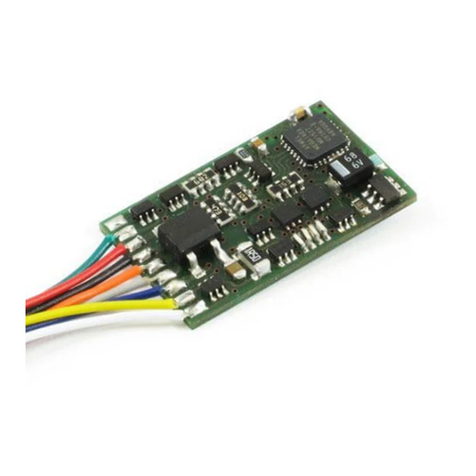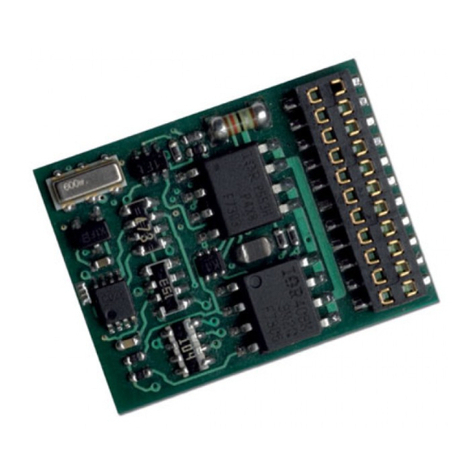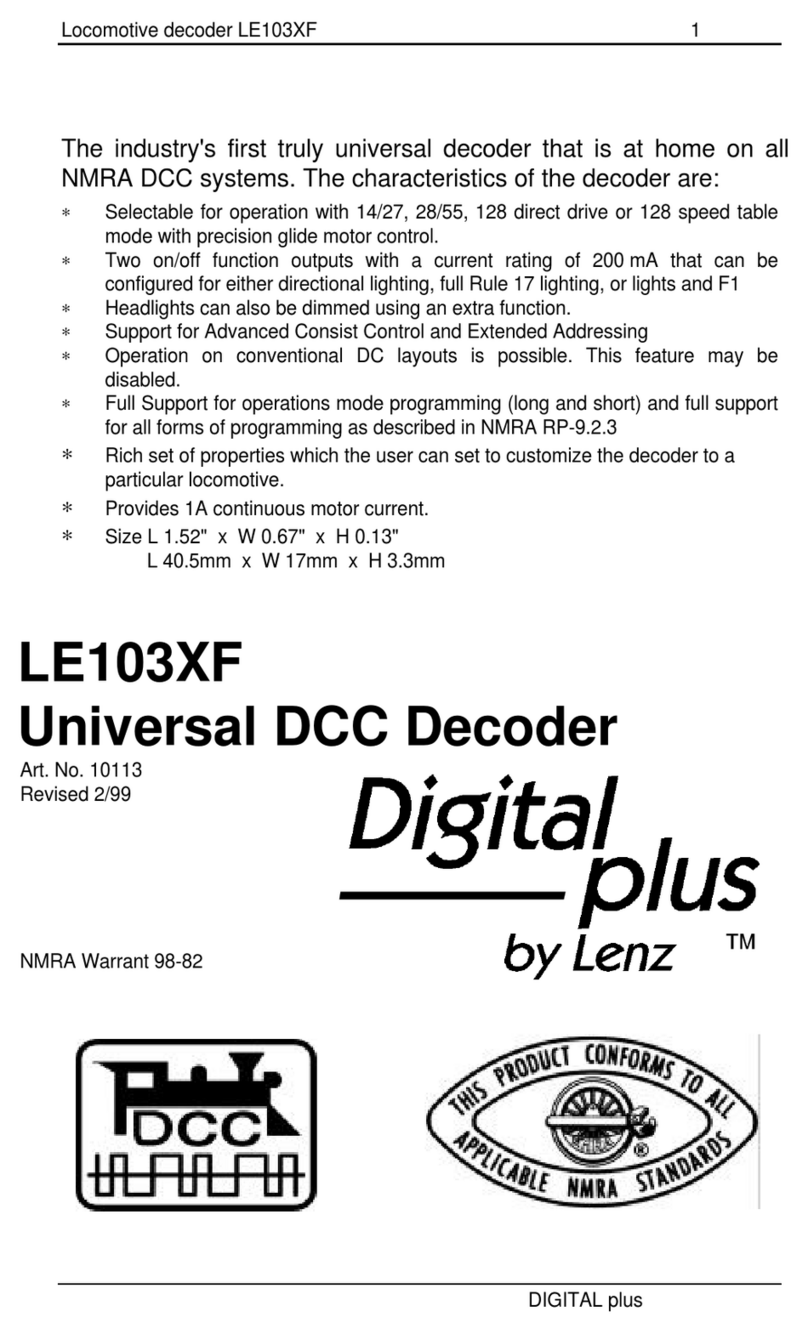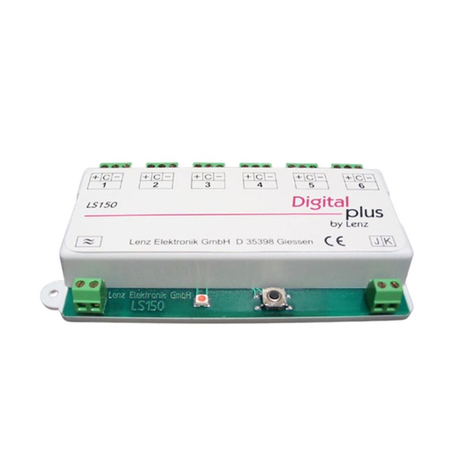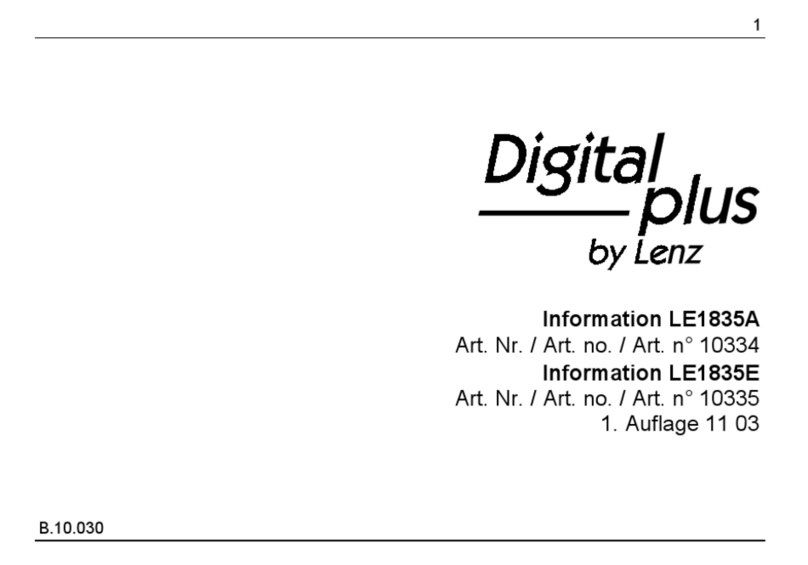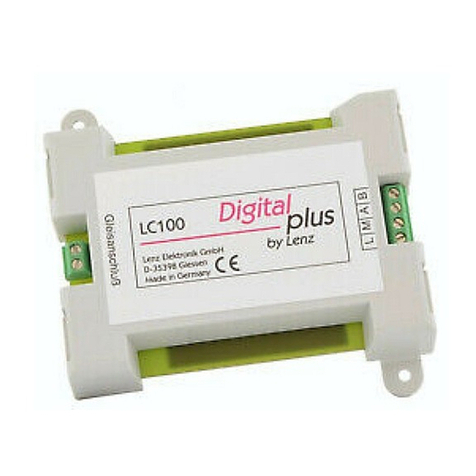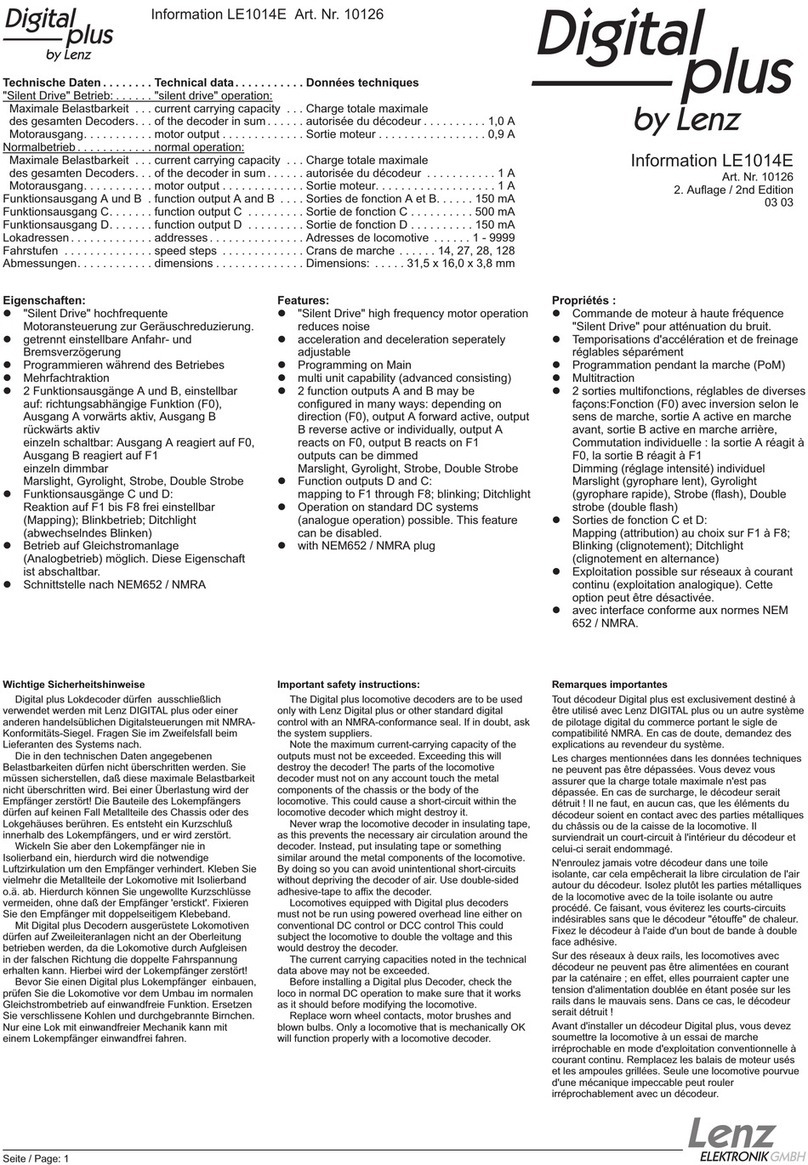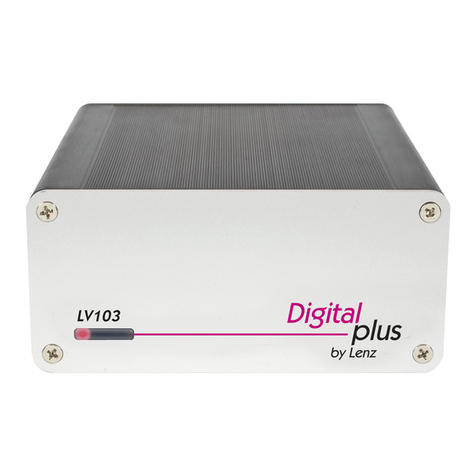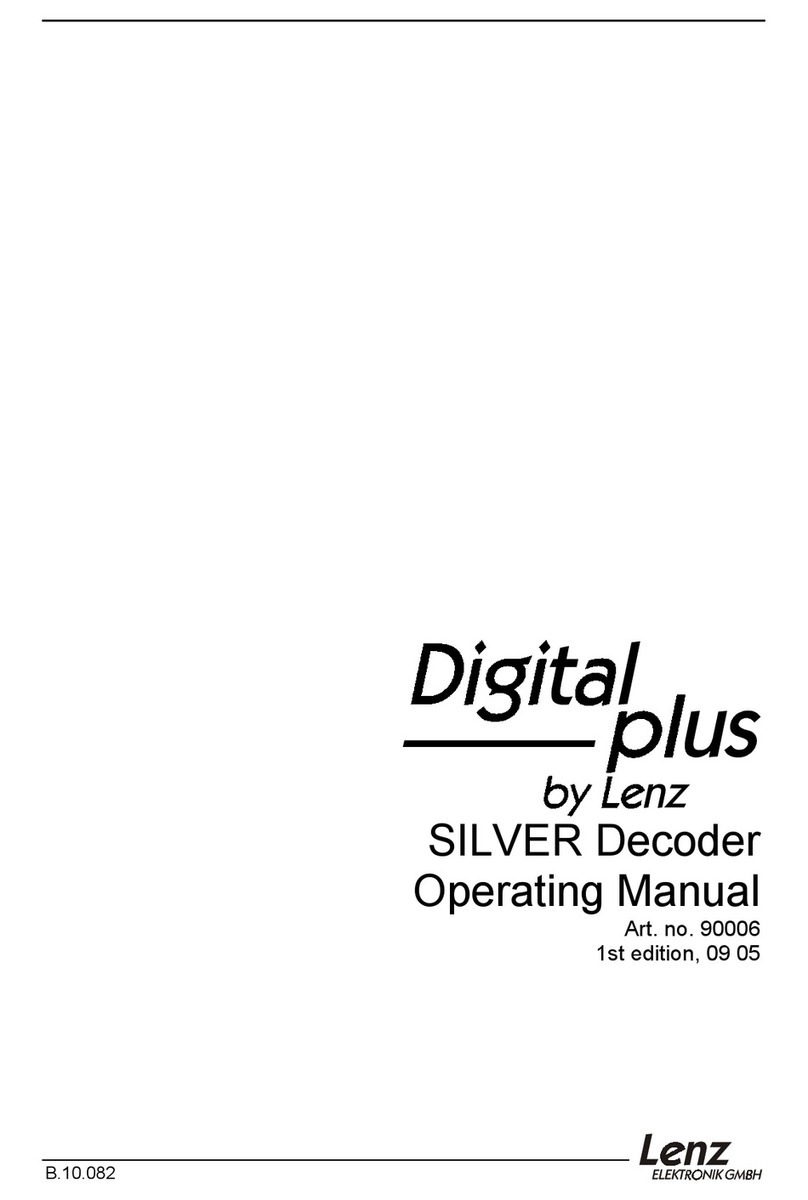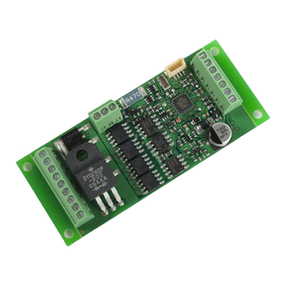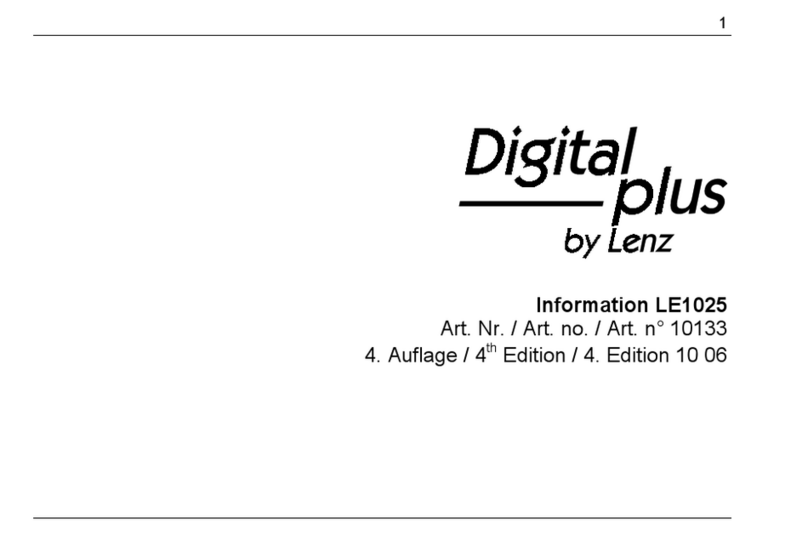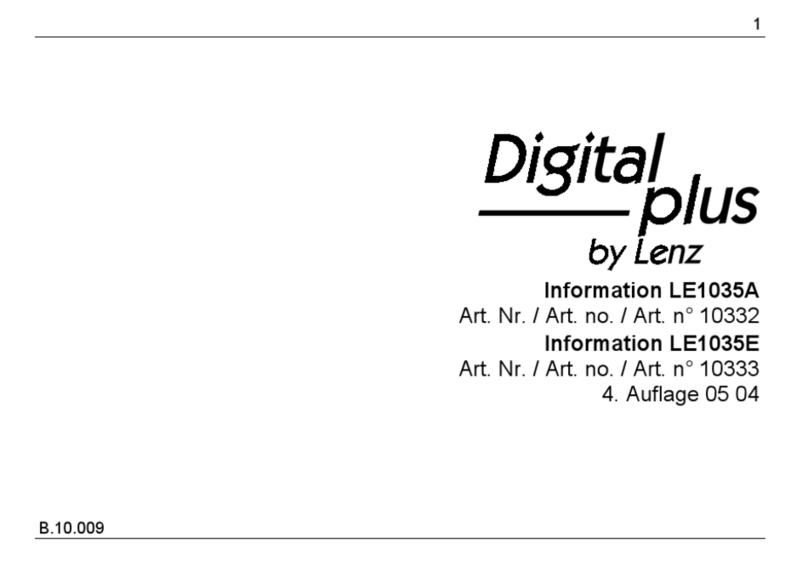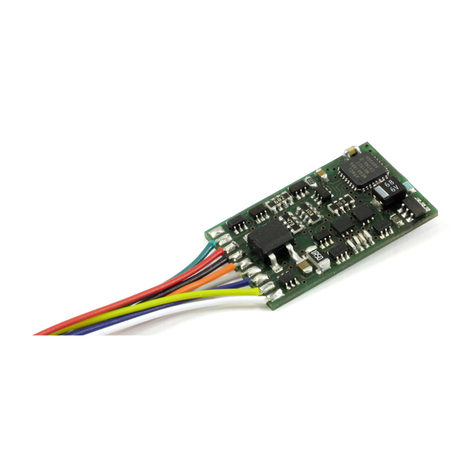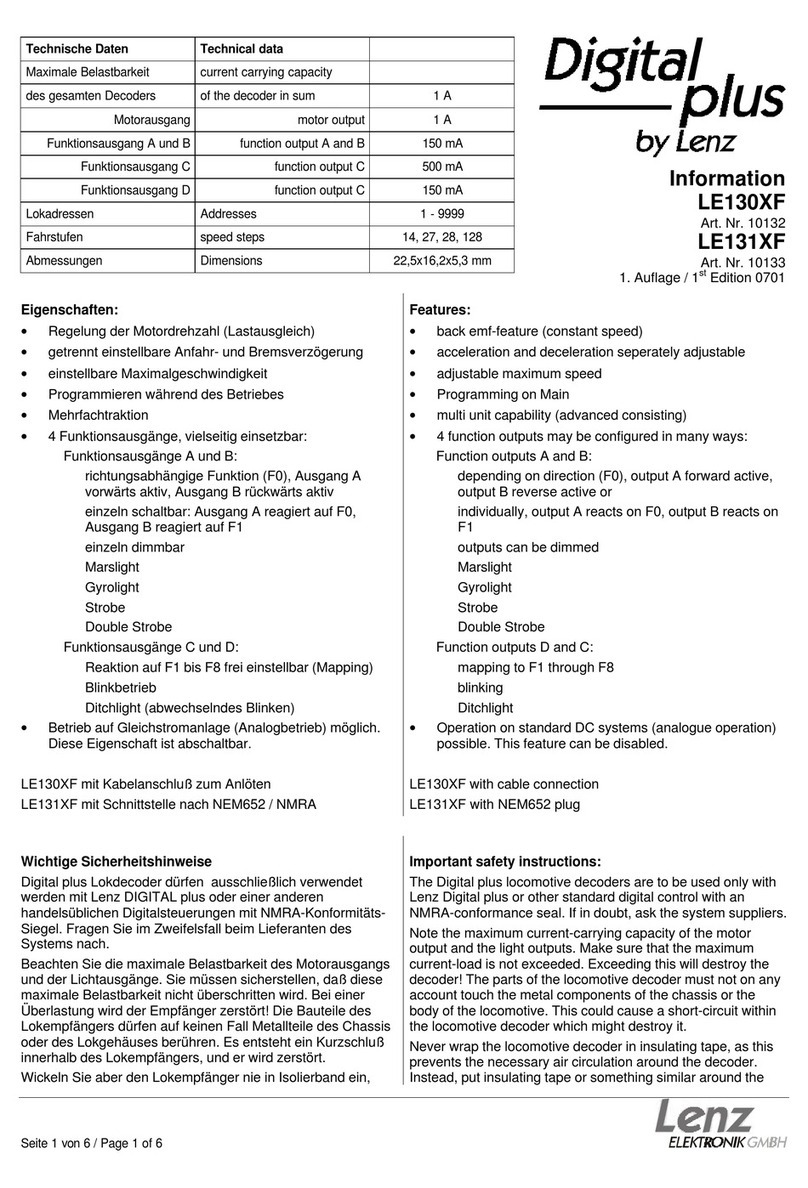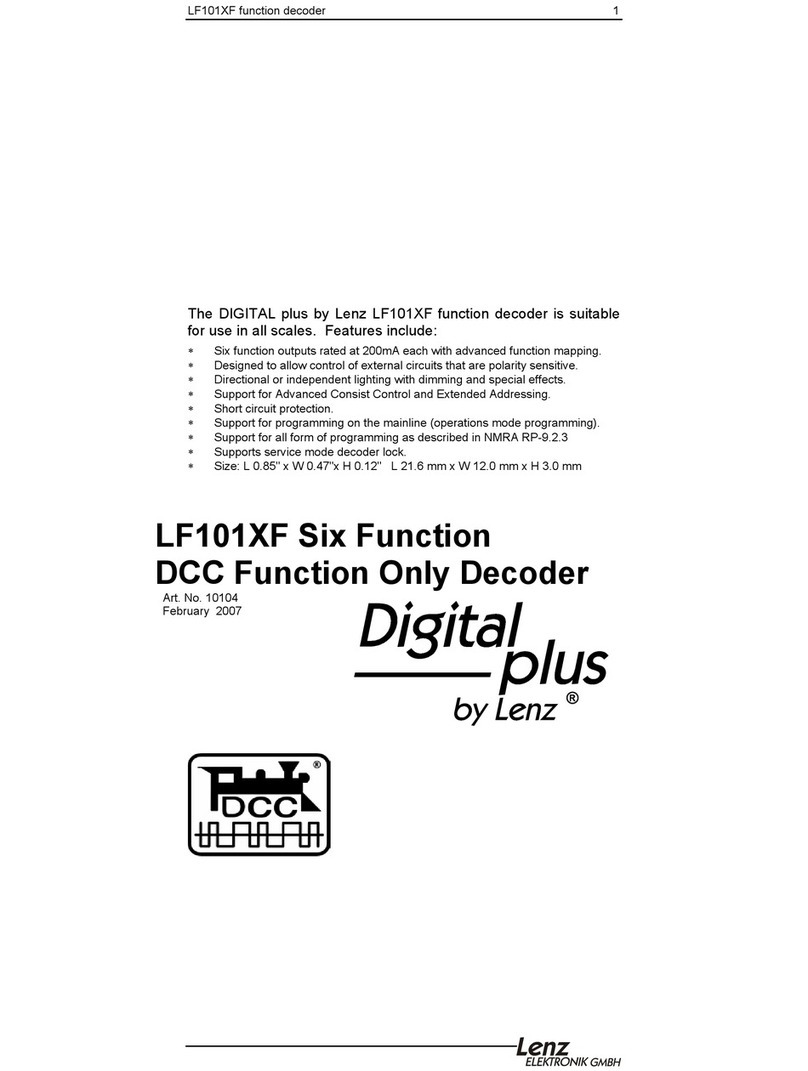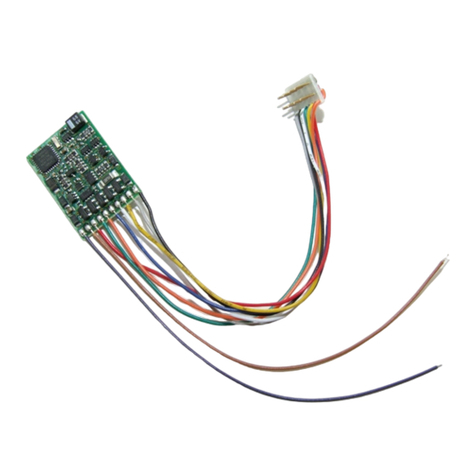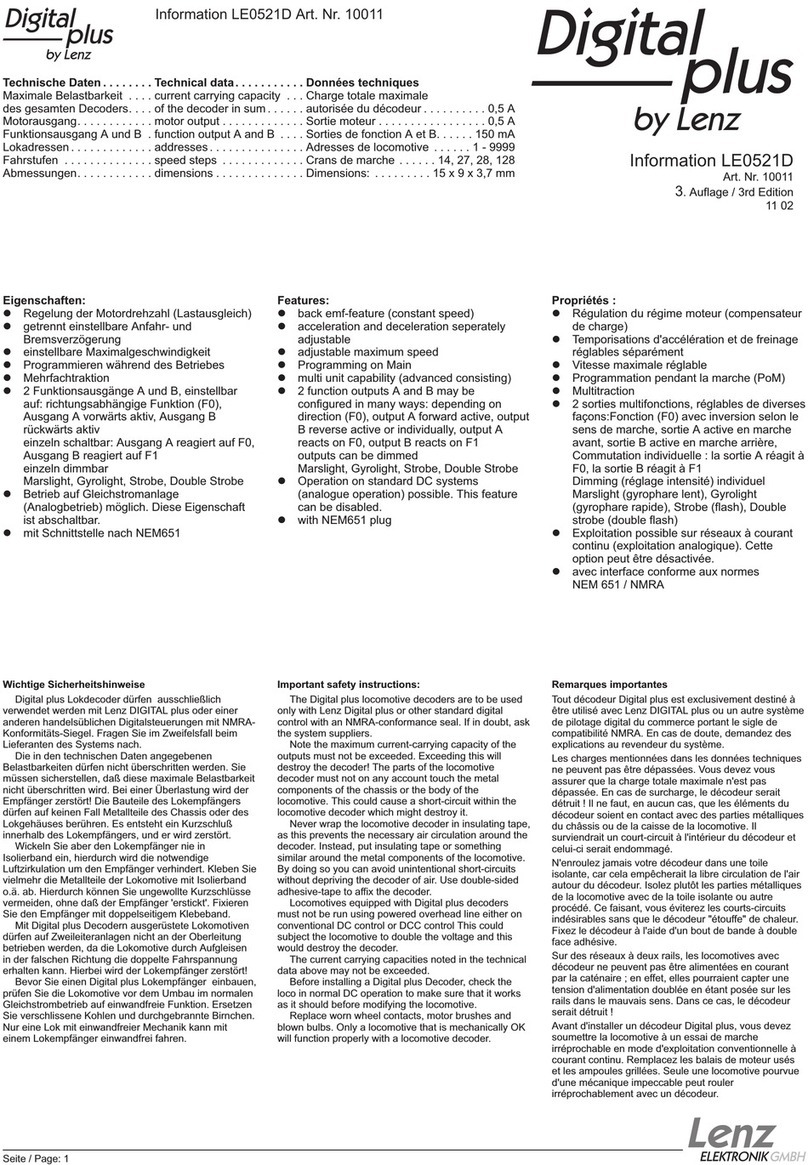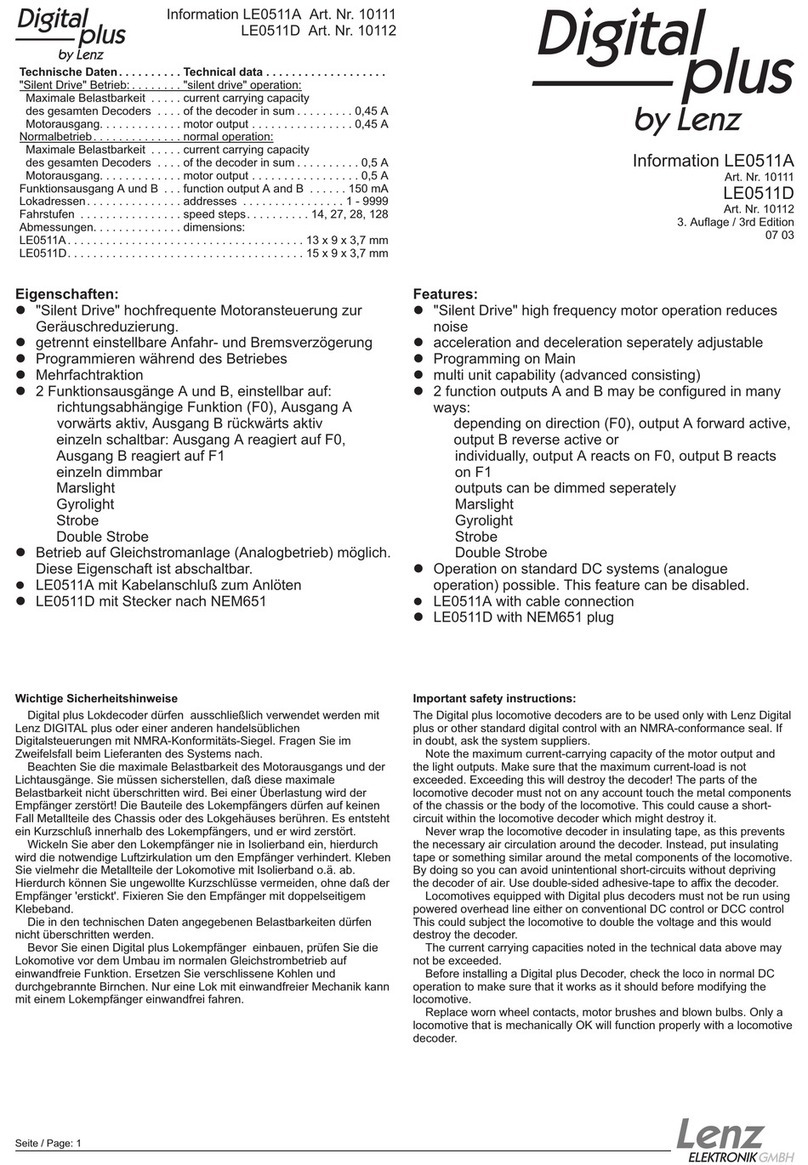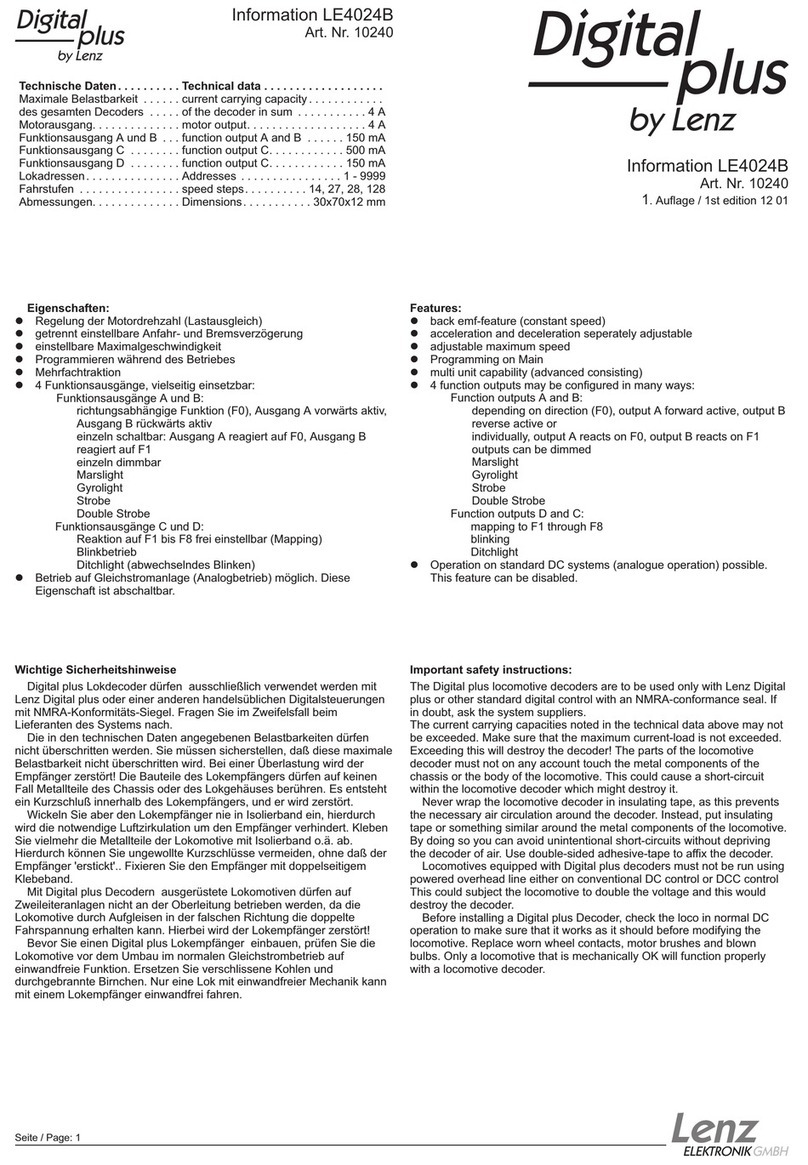
Motor
ACDBFF
Orange
Grün
Green
Vert
Violett
Purple
Information LE1014A
Seite / Page: 2
Einbau des LE1014A
Notieren Sie sich, welcher Motoranschluß mit
den rechten und welcher mit den linken
Radschleifern verbunden ist. Dies erspart Ihnen
beim Anschluß des Lokempfängers Versuche,
welches Kabel des Lokempfängers an welchen
Motoranschluß gelötet werden muß, um die
richtige Fahrtrichtung einzustellen.
Die Motoranschlüsse müssen nach Entfernen
der bisherigen Kabel potentialfrei sein. Das heißt,
sie dürfen keine Verbindung zum Chassis oder
den Lokrädern (Radschleifern) mehr haben.
Achten Sie auch darauf, daß solche
Verbindungen mitunter erst durch Aufsetzen des
Gehäuses entstehen können!
Wenn Sie sich nicht sicher sind, ob alle
Voraussetzungen zum Einbau erfüllt sind,
wenden Sie sich an einen Servicebetrieb
Schließen Sie den Lokempfänger zuerst an die
Radschleifer an:
rotes Kabel an die in Fahrtrichtung rechten
Radschleifer
schwarzes Kabel an die in Fahrtrichtung
linken Radschleifer.
Dann verbinden Sie den Empfänger mit den
Motoranschlüssen:
oranges Kabel an den Motoranschluß, der
vorher mit den rechten Radschleifern
verbunden war
graues Kabel an den Motoranschluß, der
vorher mit den linken Radschleifern
verbunden war.
Nun schließen Sie die Funktionen an. Im
Auslieferungszustand sind diese
Funktionsausgänge wie folgt eingestellt:
Ausgänge A und B reagieren
fahrtrichtungsabhängig auf F0. Diese Einstellung
kann geändert werden.
Wenn Sie die Funktionsausgänge in der
Werkseinstellung verwenden möchten, dann
verbinden Sie die Ausgänge wie folgt:
Funktionsausgang A (weißes Kabel) an das
in Fahrtrichtung vordere Birnchen,
Funktionsausgang B (gelbes Kabel) an das
in Fahrtrichtung hintere Birnchen.
Sind die Glühbirnchen nicht elektrisch mit dem
Chassis der Lokomotive verbunden (wir nennen
diese dann "potentialfrei"), so schließen Sie nun
noch den anderen Pol der Lampen an das blaue
Kabel an, wie in der Abbildung zu sehen. Besteht
eine Verbindung zwischen Glühbirnen und
Chassis, so bleibt das blaue Kabel unbenutzt. Bei
Anschluß am blauen Kabel leuchten die
Glühbirnen etwas heller, außerdem funktioniert
dann die richtungsabhängige Beleuchtung auch
im Betrieb mit normalem Gleichstrom. Welche
der Varianten Sie umsetzen, hängt von der
Konstruktion der Lokomotive ab.
Für den Anschluß von Leuchtdioden gilt:
Blaues Kabel ist "Pluspol" (Anodenseite der
LED), Funktionsausgang ist "Minuspol"
(Kathodenseite der LED). Die Spannung am
Funktionsausgang beträgt ca. 16V. Vergessen
Sie nicht den erforderlichen Vorwiderstand
l
l
l
l
l
l
Schließen Sie nun noch den
Funktionsausgang C und D an, sofern eine
weitere Funktion in Ihrer Lok vorhanden ist.
Funktionsausgang C (grünes Kabel) an
eine weitere Funktion.
Funktionsausgang D (violettes Kabel) an
eine weitere Funktion.
l
l
Installation of the LE1014A
Take note of which motor connection is linked
to the right-hand locomotive wheels and which to
the left. If you do this you will not have to try out
which cable of the decoder needs to be soldered
to which connection of the motor in order to
achieve the desired direction of travel.
After the removal of the original connections to
the motor brushes, both the motor brushes must
be potential free and completely isolated from
both tracks. This means that they must not be
connected in any way to the chassis or to the
wheels of the locomotive. Also bear in mind that
such connections are sometimes created only
when the chassis is put back!
Please contact a service centre if you are in
any doubt as to whether all preconditions for the
installation are fulfilled!
First connect the decoder to the pick-ups from
the wheels of the locomotive:
red cable to the wheels which in relation to
the direction of travel are on the right-hand
side of the locomotive
black cable to the wheels which in relation
to the direction of travel are on the left-hand
side of the locomotive
Then connect the decoder to the motor
connections:
orange cable to the motor connection
previously connected to the right-hand
locomotive wheels
grey cable to the motor connection
previously connected to the left-hand
locomotive wheels.
Now connect the functions. Ex-works default
settings for the functions are configured as
follows: function outputs A and B as direction-
dependent outputs reacting to F0. This
configuration can be altered as desired.
If you wish to use the function outputs in their
initial configuration then connect the outputs as
follows:
function output A (white cable) to the bulb
which in relation to the direction of travel is
at the front
function output B (yellow cable) to the bulb
which in relation to the direction of travel is
at the back
If the functions inside the locomotive (e.g. the
bulbs of the direction dependent lights) are not
electrically connected to the chassis of the
locomotive (i.e; if they are, "potential free") then
connect the other pole of the function to the blue
cable, as shown in the illustration. If a connection
between functions and chassis does exist, then
the blue cable remains unused. When connected
to the blue cable the bulbs shine somewhat
brighter and, in addition, the direction dependent
lighting then also works in normal DC operation.
Which option you choose depends on the design
of the locomotive.
For the connection of LEDs note that the blue
cable is the positive pole (anode side of the LED)
and the function output the negative pole
(cathode side of the LED). The voltage at the
function output is approximately 16 V. Please do
not forget the necessary protective resistor.
l
l
l
l
l
l
Now connect the outputs C and D (if your
locomotive has further functions):
function output C (green cable) to another
locomotive function.
function output D (purple cable) to a
another locomotive function.
l
l
Montage du décodeur LE1014A
l
l
sortie C (câble vert) à un dispositif de
fonction;
sortie D (câble violet) à un autre dispositif
de fonction.
Notez la correspondance entre les bornes du
moteur et les patins de prise de courant droits et
gauches. Ceci vous évitera de rechercher, lors du
raccordement du décodeur, quels câbles du
décodeur vous devrez souder aux bornes de
sortie du moteur pour que la locomotive roule
dans le bon sens.
Les sorties du moteur doivent être au potentiel
zéro après enlèvement des câbles préexistants.
Cela signifie qu'il ne doit subsister aucune liaison
avec le châssis ou avec les roues (ou patins de
roue). Veillez aussi à ce qu'une telle liaison ne
puisse survenir par inadvertance lors de la
repose de la caisse !
Si vous avez des doutes sur la conformité de la
transformation de la locomotive, adressez-vous
alors à un service compétent !
Raccordez tout d'abord le décodeur de
locomotive aux patins de roue :
Maintenant, raccordez les dispositifs de
fonction aux sorties de fonction. Voici les
réglages d'usine de celles-ci : les sorties A et B
réagissent à F0 avec inversion selon le sens de
marche et les sorties C et D réagissent à F1 et
F2. Ces réglages peuvent être modifiés.
Si vous êtes d'accord d'utiliser les sorties de
fonction telles que réglées en usine, raccordez
alors les sorties comme suit :
Si le second pôle des ampoules n'est pas relié
électriquement au châssis de la locomotive
(donc, s'il est au potentiel zéro), raccordez-le au
câble bleu (voir illustration). S'il existe une liaison
entre les ampoules et le châssis, le câble bleu
n'est pas utilisé. En cas de retour de courant par
le câble bleu, les ampoules brilleront davantage.
En outre, les feux de signalisation (avec inversion
selon le sens de marche) fonctionneront
également en exploitation conventionnelle en
courant continu. Quelle que soit la variante
choisie, elle est essentiellement dépendante du
type constructif de la locomotive.
Si votre locomotive est équipée de diodes
lumineuses, tenez compte de ceci : câble bleu =
pôle "plus" (anode de la diode) ; sortie de
fonction = pôle "moins" (cathode de la diode). La
tension entre la borne de sortie et le câble bleu
étant d'environ 16 V, n'oubliez pas de placer une
résistance adéquate en série.
Raccordez maintenant les sorties de fonction
C et D pour autant que d'autres dispositifs de
fonction existent sur votre locomotive :
l
l
l
câble rouge aux patins droits dans le sens
de marche ;
câble noir aux patins gauches dans le sens
de marche.
Ensuite, raccordez le décodeur aux sorties
moteur :
câble orange à la sortie moteur qui était
auparavant raccordée aux patins droits ;
câble gris à la sortie moteur qui était
auparavant raccordée aux patins gauches.
sortie A (câble blanc) à l'ampoule avant
(selon sens de marche sélectionné) ;
sortie B (câble jaune) à l'ampoule arrière
(selon sens de marche sélectionné).
l
l
l
Anschluß des LE1014A
Wiring the LE1014A
Montage du décodeur
LE1014A
Grau
Grey
Gris
Rot
Red
Rouge
Schwarz
Black
Noir
Weiß
White
Blanc
Gelb
Yellow
Jaune
Blau
Blue
Bleu

